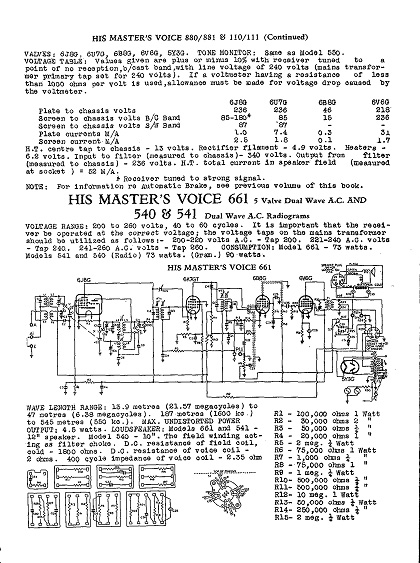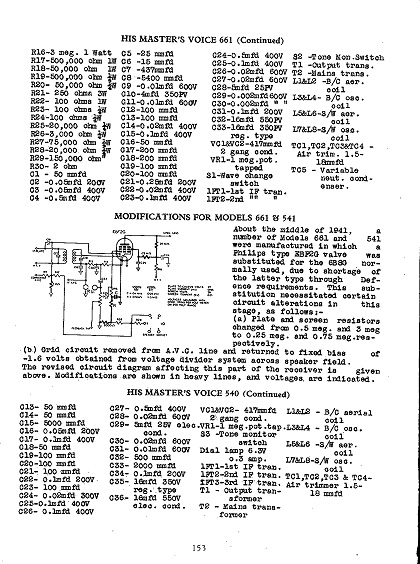Tech Talk
Forum home - Go back to Tech talk
|
HMV 1941 Model 661
|
|
|
Return to top of page · Post #: 1 · Written at 10:18:32 PM on 4 January 2010.
|
|
|
|
Location: BromeHill, WA
Member since 3 September 2009 Member #: 542 Postcount: 14 |
|
Hi everyone...Happy New Year. |
|
|
Return to top of page · Post #: 2 · Written at 12:12:35 AM on 5 January 2010.
|
|
|
|
Location: Wangaratta, VIC
Member since 21 February 2009 Member #: 438 Postcount: 5655 |
|
Rick, welcome to a nightmare. |
|
|
Return to top of page · Post #: 3 · Written at 2:48:50 PM on 5 January 2010.
|
|
|
|
Location: BromeHill, WA
Member since 3 September 2009 Member #: 542 Postcount: 14 |
|
Hi Marc, |
|
|
Return to top of page · Post #: 4 · Written at 6:26:28 PM on 5 January 2010.
|
|
|
|
Administrator
Location: Naremburn, NSW
Member since 15 November 2005 Member #: 1 Postcount: 7582 |
|
G'day Rick, ‾‾‾‾‾‾‾‾‾‾‾‾‾‾‾‾‾‾‾‾‾‾‾‾‾‾‾‾‾‾‾‾‾‾‾‾‾‾‾‾‾‾‾‾‾‾‾‾‾‾‾‾‾‾‾‾‾‾‾‾‾‾‾‾‾‾‾‾ A valve a day keeps the transistor away... |
|
|
Return to top of page · Post #: 5 · Written at 10:30:33 PM on 5 January 2010.
|
|
|
|
Location: Wangaratta, VIC
Member since 21 February 2009 Member #: 438 Postcount: 5655 |
|
Rick |
|
|
Return to top of page · Post #: 6 · Written at 10:35:06 PM on 5 January 2010.
|
|
|
|
Location: Wangaratta, VIC
Member since 21 February 2009 Member #: 438 Postcount: 5655 |
|
Forgot |
|
|
Return to top of page · Post #: 7 · Written at 11:04:53 PM on 5 January 2010.
|
|
|
|
Location: BromeHill, WA
Member since 3 September 2009 Member #: 542 Postcount: 14 |
|
OK Marc, |
|
|
Return to top of page · Post #: 8 · Written at 2:12:33 AM on 6 January 2010.
|
|
|
|
Location: Wangaratta, VIC
Member since 21 February 2009 Member #: 438 Postcount: 5655 |
|
Rick |
|
|
Return to top of page · Post #: 9 · Written at 9:09:10 PM on 6 January 2010.
|
|
|
|
Administrator
Location: Naremburn, NSW
Member since 15 November 2005 Member #: 1 Postcount: 7582 |
|
Images are up gentlemen. Sorry about the delay. ‾‾‾‾‾‾‾‾‾‾‾‾‾‾‾‾‾‾‾‾‾‾‾‾‾‾‾‾‾‾‾‾‾‾‾‾‾‾‾‾‾‾‾‾‾‾‾‾‾‾‾‾‾‾‾‾‾‾‾‾‾‾‾‾‾‾‾‾ A valve a day keeps the transistor away... |
|
|
Return to top of page · Post #: 10 · Written at 11:13:41 PM on 6 January 2010.
|
|
|
|
Location: Wangaratta, VIC
Member since 21 February 2009 Member #: 438 Postcount: 5655 |
|
Brad, |
|
|
Return to top of page · Post #: 11 · Written at 11:54:37 PM on 6 January 2010.
|
|
|
|
Location: BromeHill, WA
Member since 3 September 2009 Member #: 542 Postcount: 14 |
|
Thanks Gentlemen, |
|
|
Return to top of page · Post #: 12 · Written at 10:02:51 PM on 7 January 2010.
|
|
|
|
Location: BromeHill, WA
Member since 3 September 2009 Member #: 542 Postcount: 14 |
|
Found that the HT is being pulled down to 140v by the 6V6. Suspect audio coupling cap to grid or cathode cap . It is driving me crazy so will put it aside for a few days. |
|
|
Return to top of page · Post #: 13 · Written at 11:14:10 PM on 8 January 2010.
|
|
|
|
Location: Wangaratta, VIC
Member since 21 February 2009 Member #: 438 Postcount: 5655 |
|
The 6V6 may be internaly shorted, that is not uncommon. Also use a multimeter to check that pin 8 has no contact with pins 2 & 7 |
|
|
Return to top of page · Post #: 14 · Written at 11:57:41 PM on 10 January 2010.
|
|
|
|
Location: BromeHill, WA
Member since 3 September 2009 Member #: 542 Postcount: 14 |
|
Hi Marc, |
|
|
Return to top of page · Post #: 15 · Written at 2:03:22 AM on 11 January 2010.
|
|
|
|
Location: Wangaratta, VIC
Member since 21 February 2009 Member #: 438 Postcount: 5655 |
|
I would not panic about the socket, they are readily available. |
|
|
You need to be a member to post comments on this forum.
|
|

Sign In

Vintage Radio and Television is proudly brought to you by an era where things were built with pride and made to last.
DISCLAIMER: Valve radios and televisions contain voltages that can deliver lethal shocks. You should not attempt to work on a valve radio or other electrical appliances unless you know exactly what you are doing and have gained some experience with electronics and working around high voltages. The owner, administrators and staff of Vintage Radio & Television will accept no liability for any damage, injury or loss of life that comes as a result of your use or mis-use of information on this website. Please read our Safety Warning before using this website.
WARNING: Under no circumstances should you ever apply power to a vintage radio, television or other electrical appliance you have acquired without first having it checked and serviced by an experienced person. Also, at no time should any appliance be connected to an electricity supply if the power cord is damaged. If in doubt, do not apply power.
Shintara - Keepin' It Real · VileSilencer - Maintain The Rage



